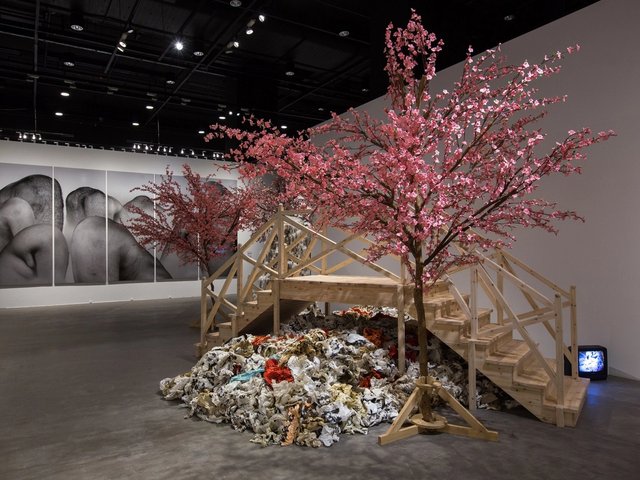Although M+, Hong Kong’s vast museum for visual arts, does not open until 2019, it is beginning to offer glimpses of what to expect. Eighty pieces from the Swiss collector Uli Sigg’s donation of close to 1,500 works were shown in Umeå, Sweden last year and starting 1 July, a slightly different cluster of works is at the Whitworth Art Gallery in Manchester, UK—the last European venue for the display before it begins an Asian tour leading up to the museum’s opening.
Sigg—who initially worked in business in Beijing before becoming the Swiss ambassador there—has built one of the largest and most comprehensive holdings of Chinese contemporary art, after realising in the 1990s that both private and institutional collections of such work had been put together in a “purely random manner”. He began to eschew personal taste as a collector at that point, in order to “mirror the art production of the experimental artists living in the People’s Republic of China chronologically, and across all media”—a mission statement worthy of a museum rather than an individual.
Although just five per cent of the collection is in Manchester, it clearly reflects the diversity Sigg sought. Arranged into three sections, it covers four decades of production starting in the mid-1970s, when the No Name group took great risks in creating art outside the Chinese government’s restrictions.
The shifts that occurred in the country’s contemporary art are a microcosm of the pace of change in China as a whole. Paintings by No Name artists like Zhang Wei and Feng Guodong, and those by Huang Rui from the more avowedly political Stars group, are modest to Western eyes—they wouldn’t find their way on artistic merit into many major museum collections—but you can’t underestimate their significance as a mark of artists working around state control.
Very quickly, there was a huge transformation in Chinese art, informed by an influx of books on Modern and contemporary Western art and exhibitions including one on Robert Rauschenberg in 1985. The speed with which Chinese artists adopted and adjusted the languages of the Western avant-gardes—particularly Dada, Pop and conceptualism—was remarkable.
Key movements are reflected in the show: Zhang Peili, who founded the Pond Society in the 1980s, made spare paintings of latex gloves and also posted instructions on how to make them to other artists; Wang Guanyi’s image of Mao imprisoned behind a conceptualist grid exemplifies the Political Pop group’s iconoclastic ethos; and Fang Lijun’s garishly coloured untitled painting of sinister shaven-headed figures, made in 1995, reflects the so-called Cynical Realism movement.
The superstars of the Chinese scene are here, too, among them Ai Weiwei, through a Minimalist-inspired gathering of axeheads, Still Life (1995-2000)—one of his arcane comments on value and antiquity rather than an aggressively political work. Zhang Huan’s well-known photographic series Family Tree (2000), in which calligraphers ink Zhang’s face with his family history, eventually turning it completely black, remains a powerful sequence.
The period after 2000 is dominated by reflections on globalisation and a changing China. Cao Fei’s video Whose Utopia (2006) addresses the Made in China phenomenon, capturing Osram factory workers performing their mundane tasks and then expressing their individuality through performance, while urban transformation is addressed both in Xing Danwen poetic photographs and Weng Fen’s satirical plays on the idealism of developers’ architectural models. Significantly, the exhibition includes none of the traditional-style ink paintings that continue to dominate the Chinese market.
A show of 80 works by 30 artists stretching across 40 years is bound to be uneven. But as a concise guide to Sigg’s collecting strategy, the breadth of work that will eventually occupy the cavernous spaces of M+, and the key moments in what remains a relatively young contemporary art scene, the Whitworth’s exhibition is a useful taster.
• M+ Sigg Collection: Chinese Art from the 1970s to Now, 1 July-20 September, Whitworth Art Gallery, Manchester, UK



